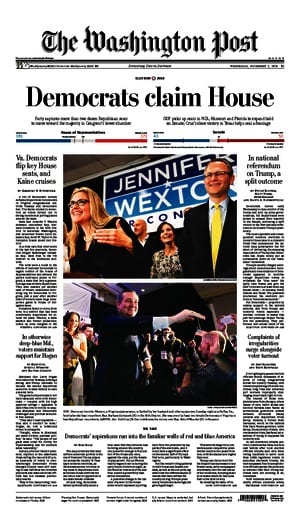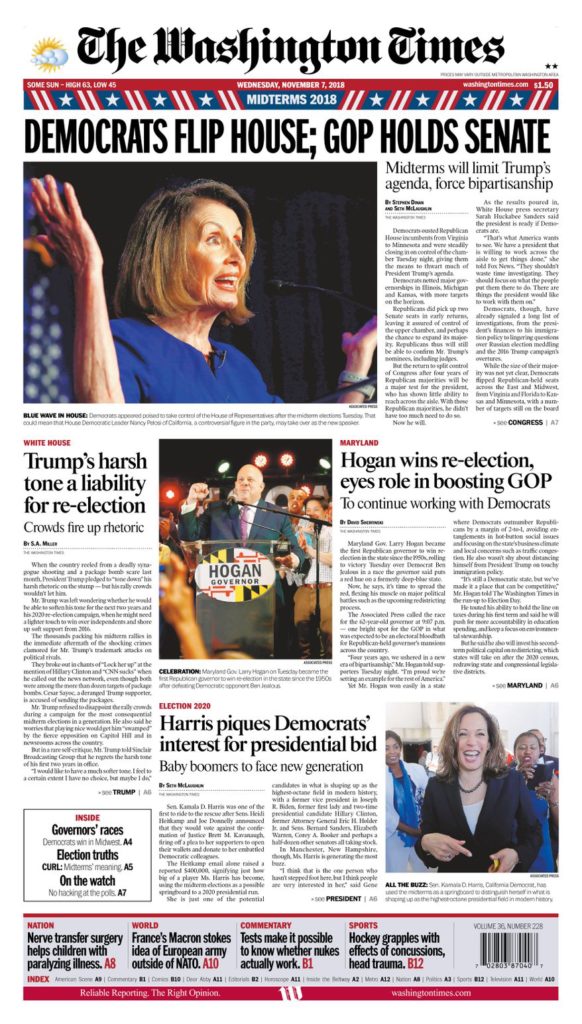In the end, the “blue wave” was no tsunami and despite washing through America’s suburbs it largely evaporated on the beaches of Florida.
 Last night’s midterms proved a “glass half-full” kind of evening, with something for both sides. On one hand it was a victory for checks and balances and a limitation on Donald Trump as the Democrats achieved their primary aim of taking control of the House of Representatives and its major committees as levers of oversight.
Last night’s midterms proved a “glass half-full” kind of evening, with something for both sides. On one hand it was a victory for checks and balances and a limitation on Donald Trump as the Democrats achieved their primary aim of taking control of the House of Representatives and its major committees as levers of oversight.
Meanwhile, the Senate became redder and now looks set to reinforce Republican resistance to any attempts to reverse the president’s agenda. Also, far from a widespread repudiation of divisive, hyper-partisan rhetoric, in many cases voters endorsed candidates who were largely extensions of Trump’s politics.
But while the “rock star” campaigns of Andrew Gillum in Florida and Beto O’Rourke in Texas came up short, they, along with Stacey Abrams – who is still breathing in her hugely controversial race in Georgia – have undoubtedly shaken up the established political order in their states. Along with other younger candidates they may have helped establish a new “bench” of potential Democratic leadership with 2020’s presidential cycle fast approaching.
Yet alongside those high-profile disappointments, there were some historic wins for the Democrats, and the political landscape will look very different come January. Here are some headlines from the evening:
- The new congress will contain a record number of women, including the first muslim women, the first native Americans, and the youngest-ever woman – Alexandria Ocasio-Cortez in New York.
- Democrat Jacky Rosen defeated Republican Nevada Sen Dean Heller, who represented the GOP’s most vulnerable senate seat.
- Republican Marsha Blackburn became Tennessee’s first woman senator.
- Missouri Democrat Claire McCaskill lost her seat to Republican Josh Hawley.
- Democrats Joe Donnelly (Indiana) and Heidi Heitkamp (North Dakota) lost their senate seats, due perhaps in part to the fallout from their opposition to the confirmation of Supreme Court justice Brett Kavanaugh.
- Mitt Romney returned to politics, winning a senate seat in Utah.
- Former NFL player Colin Allred defeated Republican incumbent Rep Pete Sessions in Texas.
- There were big wins for three Democratic women – Jennifer Wexton, Elaine Luria and Abigail Spanberger in key House contests in Virginia.
- Three candidates – Democrat Bob Menendez and Republicans Chris Collins and Duncan Hunter – were re-elected despite having been accused of federal crimes.
- Democrat Max Rose won a congressional seat in Staten Island, formerly a Republican stronghold.
- In significant statehouse victories, Democrats defeated Scott Walker in Wisconsin and Kris Kobach in Kansas. In Colorado, Jared Polis became the first openly gay Governor in the United States.
Full results in detail:
Washington Post results for the House of Representatives here
Washington Post results for the Senate here
Washington Post results for the Governors’ races here
 As of early on Wednesday morning, there were still some races too close to call – including the interesting Arizona Senate contest between Martha McSally and Kyrsten Sinema.
As of early on Wednesday morning, there were still some races too close to call – including the interesting Arizona Senate contest between Martha McSally and Kyrsten Sinema.
Overall, voter turnout reached historic proportions for an off-year election. Significantly, young voters appeared to split roughly two-to-one for Democrats, and there were huge increases – admittedly from low bases – in early voting turnout among new and young voters. Demographic changes are certainly under way, but the fact that so many races last night finished so close shows that the country will likely remain pretty evenly split going forward.
While re-districting and voting changes will be back on the agenda, the new government will still have to govern, and it will be interesting to see the extent to which president Trump will feel disposed to make legislative deals with the resurgent House Democrats, or whether he will want to be able to point to their “obstructionism” as something to attack on as his seemingly perpetual campaign continues.
Fear itself
One week before election day was the 80th anniversary of the famous ‘War of the Worlds’ radio broadcast by Orson Welles’ Mercury Theater.
Most who listened heard it as a drama, fewer as real life. But with the perspective of history, that night became shorthand for a popular image of what people are willing to believe – even if, in reality, the hysteria wasn’t as widespread as many might think. One explanation was that America’s newspapers – their advertising revenue threatened by the rise of radio – hyped the idea of a mass panic as they took the opportunity of discrediting the new medium.
Editor and Publisher magazine wrote at the time that “The nation as a whole continues to face the danger of incomplete, misunderstood news.” Sound familiar?
In the future, we may come to think the same way about the run-up to Tuesday’s mid-terms; where the stories coming from the White House were no less panic-inducing and falsehoods had become second nature. According to the Washington Post, the president lied more in September and October combined than in the rest of his presidency combined.
President Trump very specifically chose to make the election a referendum on himself. He could have spent the final weeks and days of the campaign talking up the economy; drawing attention to strong job growth and low unemployment – regardless of how much credit he might actually warrant. But instead, he chose to make it about fear and anxiety among his base.
And no matter the outcome last night, his ego was always going to spin it as a victory. He continues to think of the country, as historian Jon Meachem said, as an audience rather than an electorate. The big question was always going to be how much the election would be a repudiation of President Trump, and what was going to be the collateral damage among Republican candidates.
What last night showed is that the country is still as divided as ever, and the president will believe, justifiably, that his final red-meat rhetoric-fueled push in those last three rallies – even bringing Fox News commentator Sean Hannity on stage – especially around the issue of the migrant “caravan”, worked.
The controversial militarization of that situation, with the president ordering troops to the southern border, appeared to be shaping up to become a production almost of Wag The Dog proportions. Former GOP strategist Rick Wilson called it “performance art” and, like Orson Welles’ broadcast, it seemed to demonstrate that voters can be convinced of anything if they’re pre-disposed to believe it.
Writing in the New Yorker on election eve, Susan Glasser said that whatever happened yesterday, one thing is sure: the outcome wouldn’t heal the country’s divide. Her piece called it the “dark certainty” of the midterms.
“Most Americans still disagree with Trump, but what is remarkable is the extent to which even those who hate him are forced to conduct the debate on the terms he has set,” she writes. “In redefining American politics to suit his own explosive style, Trump has got inside our heads much more deeply than he was during the 2016 campaign, when we still had the luxury of tuning him out at times and believing he would not be around much longer.”
And that’s the mistake many people have probably made – assuming that this presidency is an aberration, an outlier; that he might “not be around much longer”. Whenever and however the end of the Trump presidency might come, in terms of his impact on the Republican party and the broader US political system, we’ll be seeing his influence for years. The question is, can America work around it?
Yesterday might be a start.
Also published on Medium.
